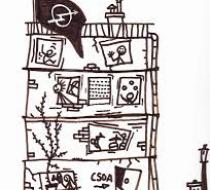Centros Sociales Okupados Autogestionados (CSOAs) in Spain: From abandoned houses to activist enclaves 1 Favorite
A Centro Social Okupado Autogestionado (Self-Managed Occupied Social Center) or CSOA is an occupied building dedicated to the development of social and cultural activities. They are part of the “movimiento okupa” (“squatter movement”), a label created and circulated by the mainstream press.
Although CSOA is the most common denomination, this spaces can be called “Espacios Sociales Okupados Autogestionados” (Self-Managed Occupied Social Spaces) or ESOAs. In Catalonia they receive the name of Casal or Can, and in the Basque Country they are called Gaztetxes. Besides this denomination, that was improted from the Italian movement, each one of these centers has they own name. These names are usually related to the street where the center is, the previous activities that took place in the building (if, for example, the building was a factory or a laboratory), or they come straight from the squatter’s imagination.
CSOAs started to flourish during the 80, although it is possible to argue that the anarchist cultural centers from the first third of the 20th century are their predecessors. Right now, in the city of Madrid there are 55 active CSOAs.
The intention behind CSOAs is to satisfy the need of a portion of the population of alternative leisure activities that are not inserted in the frame of consumerism and trade. In most CSOAs one can find all kind of workshops (music, painting, sewing, bike repairing, recycling, open-access technologies), free/affordable concerts, talks, organized lunches and dinners, and crowd-funding activities for specific groups. For example, it is common for CSOAs to host parties to help people that have been arrested in a protest with their legal expenses.
In general, any group or organization that needs a space for their activities can count on CSOAs if they agree to organize them and leave the space in the same condition they found it: Youth organization, unions, associations, social movements, community movements, cooperatives, communes, groups of artists and musicians, neighborhood assemblies, free radio broadcasters…
The organization of CSOAs is usually assembly-based and horizontal. Although there are sometimes specific “positions” within the CSOA, these only involve certain responsibilities, never a hierarchy. Thus, some CSOAs have a treasurer, a propaganda manager, a space manager that distributes the times and rooms among the groups and associations, a librarian if there is a library, etc.
CSOAs are usually located in abandoned buildings that belong to private and public owners. Since the 2008 crisis, there has been a tendency to prioritize the occupation of abandoned buildings owned by banks, and especially by banks involved in the crisis, like Bankia. The intervention of the owners through legal and judicial actions is usually the reason why a CSOA ceases to exist.
The different neighborhoods and communities react in diverse ways when there is a new CSOA in the area. For some people, CSOAs are a way to rehabilitate old buildings that were neglected by their owners, a way to provide the neighbors with free cultural activities and a place of coexistence and of popular empowerment. For other people, CSOAs are illegal spaces snatched by force. Real estate companies, business owners associations, local government and right-wing movements are the main actors of this last group.










